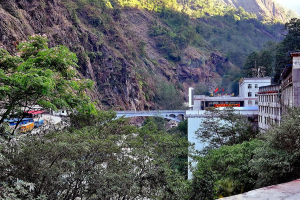Summary
In spite of denial by the Nepalese government, there are media reports about Chinese “encroachment” into Nepali land along their border. Due to its contiguity, any such territorial changes are consequential to India.
In June 2019, Nepal’s parliament adopted a new map of its country that shows India-controlled lands on the northwestern border – in Lipulekh, Kalapani and Limpiyadhura – as its territory. This has disturbed the bilateral relationship between the two South Asian neighbours who have had old civilisational ties. For those who talk about saving these civilisational ties, a pertinent question to think about is why was this forgotten when India imposed economic blockade on Nepal in 1989 and again in 2015-16? The Indian government has, of course, denied the latter.
Like India, Nepal and China share a 1,414-kilometre long border. Historically, one of the earliest records of friction between Nepal and Tibet (now a part of China) occurred in 1789. Peace was restored after the Betrawati Treaty was signed on 20 October 1792 under which the King of Nepal agreed to, without fail, send a mission and gift to Peking every five years. This mission system continued till 1906.
In 1856, Nepal and Tibet had another clash in which Nepalese forces under the command of Prime Minister Jung Bahadur Rana emerged victorious. On 24 March 1856, the two sides signed a treaty under which Tibet ceded the ryots of Kerong, Kuti, Junga, Tagla Khar, Chewur and Dhakling to Nepal. It was also agreed that the Gurkha troops stationed in the North of Bhairab Langar would be withdrawn, which turned into a de facto border between Tibet and Nepal. Tibet had to also pay money annually to the Gurkha king. The treaty, however, could not prevent the occasional skirmishes but it settled the border between Nepal and Tibet.
Decades later, on 20 September 1950, Nepal and China signed an agreement which primarily concerned with trade and intercourse between the two countries. Under Article III of the agreement, the two countries abrogated all past treaties and documents between them. On 21 March 1960, Nepal and China signed a treaty which stipulated that the “traditional customary line” would serve as the basis for their boundary treaty. The Joint China-Nepal Boundary Commission was set up to look at and demarcate their boundaries. After deliberation, the Joint Commission and the Joint Survey Teams produced a detailed report. The issue related to Mount Everest was left to the head of the two governments. Finally, on 5 October 1961, Nepal and China signed the Boundary treaty. The protocol to the treaty was signed on 23 January 1963.
Upon his return to Nepal after signing the treaty, King Mahendra said, “Nepal has gained 300 sq miles and I feel that all the Nepalese will experience a sense of glory when I state that Sagarmatha, on which the eyes of the world seem to be focussed, continues to be as it has been ours and within our territory.”
Despite the treaty, problems remain on Nepal’s border with China. It is now being reported that Beijing has “encroached” into about 36 hectares (some reports put it 33 hectares) of Nepal’s land. This was revealed in a report by the survey department of the Nepal’s agriculture ministry. The leaked report shows that due to rapid road expansion projects by China in the region, Nepal could lose hundred acres of land. The main loss is in Sankhuwasabha, Rasuwa, Sindhupalchowk and Humla.
In the past, there were protests against such encroachment of Nepal’s land by China. However, Nepal’s government has downplayed any such report of land encroachment by China. Appearing in a talk show on a Nepalese television on 12 November 2019, Nepal’s Foreign Minister, Pradeep Gyawali, said that the country did not have any major border disputes with China. He reiterated the same on 26 June 2020 and rejected the point that China had encroached into Nepalese territory. On this issue, China earlier said that the “accusations are baseless and totally aim to confuse right and wrong and divert public attention.”
It is also being apprehended that the Chinese projects on the Nepal-China border regions and any activities in the upper stream could alter the flow of rivers originating in Tibet such as Karnali, Kali Gandaki (near Tibet-Nepal border), Trishuli, Sunkoshi, Tamkoshi and Arun. It has to be noted that River Ganga receives between 40 and 46 per cent of the waters from Nepali rivers flowing into India and meeting it, while this contribution rises to between 70 and 75 per cent during the lean season.
In 2019, River Arun began changing its course after China started a constructing embankment on it without informing Nepal. In order to not alter the course of the transboundary rivers, it was agreed under the Nepal-China Boundary Management Agreement of 2019 that the two sides would not “deliberately change or cause to change the course of any boundary river”. In case the river changes its course, the agreement states that both sides will take all necessary measures to restore it to its original course.
It has been reported that New Delhi is aware of the negative impact of this and is evaluating changes, if any, on the Nepal-China border. At the end of the day, the best way for India to deal with the situation is to politically engage with Nepal.
. . . . .
Dr Amit Ranjan is Research Fellow at the Institute of South Asian Studies (ISAS), an autonomous research institute at the National University of Singapore (NUS). He can be contacted at isasar@nus.edu.sg. The author bears full responsibility for the facts cited and opinions expressed in this paper.
Photo Credit: Wikimedia Commons
-
 More From :
More From :
-
 Tags :
Tags :
-
 Download PDF
Download PDF



